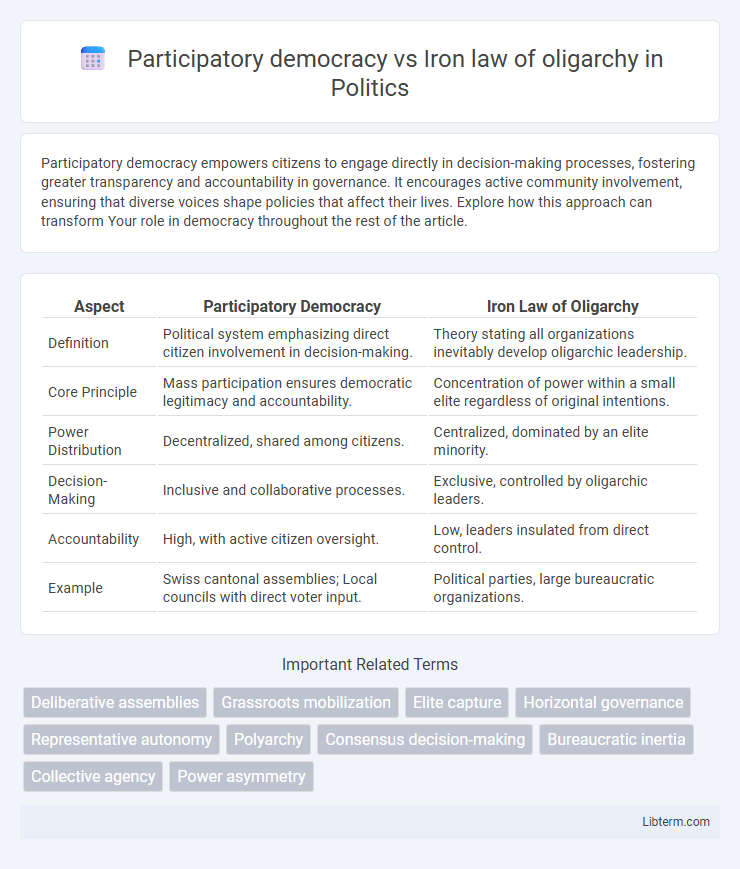Participatory democracy empowers citizens to engage directly in decision-making processes, fostering greater transparency and accountability in governance. It encourages active community involvement, ensuring that diverse voices shape policies that affect their lives. Explore how this approach can transform Your role in democracy throughout the rest of the article.
Table of Comparison
| Aspect | Participatory Democracy | Iron Law of Oligarchy |
|---|---|---|
| Definition | Political system emphasizing direct citizen involvement in decision-making. | Theory stating all organizations inevitably develop oligarchic leadership. |
| Core Principle | Mass participation ensures democratic legitimacy and accountability. | Concentration of power within a small elite regardless of original intentions. |
| Power Distribution | Decentralized, shared among citizens. | Centralized, dominated by an elite minority. |
| Decision-Making | Inclusive and collaborative processes. | Exclusive, controlled by oligarchic leaders. |
| Accountability | High, with active citizen oversight. | Low, leaders insulated from direct control. |
| Example | Swiss cantonal assemblies; Local councils with direct voter input. | Political parties, large bureaucratic organizations. |
Introduction to Participatory Democracy
Participatory democracy emphasizes direct involvement of citizens in decision-making processes, fostering transparency, accountability, and collective empowerment. It contrasts sharply with the iron law of oligarchy, which suggests that all organizations, regardless of how democratic they are initially, inevitably develop oligarchic structures dominated by a few leaders. The core principle of participatory democracy lies in maximizing public engagement to ensure that power remains broadly distributed among the populace.
Defining the Iron Law of Oligarchy
The Iron Law of Oligarchy, formulated by sociologist Robert Michels, asserts that all complex organizations inevitably develop oligarchic structures, concentrating power in the hands of a few leaders regardless of democratic intentions. This law challenges the principles of participatory democracy by highlighting the tendency for decision-making authority to become centralized, limiting broad-based citizen participation. Examining Michels' theory reveals inherent structural constraints that impede sustained grassroots control in democratic institutions.
Historical Origins and Evolution
Participatory democracy emerged in the early 20th century as a response to elitist political structures, emphasizing direct citizen involvement in decision-making processes, particularly within social movements and grassroots organizations. The iron law of oligarchy, formulated by Robert Michels in 1911, posits that all complex organizations inevitably evolve into oligarchies, concentrating power in the hands of a few, regardless of democratic intentions. Historically, participatory democracy sought to counterbalance this tendency by promoting decentralized governance, yet over time both concepts have influenced debates on organizational dynamics and the feasibility of sustained mass participation.
Key Principles of Participatory Democracy
Participatory democracy emphasizes direct involvement of citizens in decision-making processes, ensuring transparency, equality, and active civic engagement as key principles. It prioritizes decentralization of power and promotes inclusive participation to reflect diverse community interests. This approach contrasts with the Iron Law of Oligarchy, which argues that all organizations inevitably concentrate power in the hands of a few leaders.
Mechanisms of Oligarchic Control
Mechanisms of oligarchic control in participatory democracy manifest through the consolidation of power by a small group, limiting broad citizen influence despite formal inclusiveness. Centralized decision-making, bureaucratic routines, and control over information channels enable elites to dominate participatory structures. These mechanisms reinforce hierarchical authority, undermining the ideal of equal participation and facilitating the entrenchment of oligarchic rule.
Case Studies: Real-world Applications
Participatory democracy thrives in cases like the Porto Alegre participatory budgeting in Brazil, where citizen involvement directly influenced municipal spending, showcasing enhanced transparency and public trust. Contrastingly, the Iron Law of Oligarchy is evident in organizations like the early 20th-century labor unions, where leadership consolidation limited grassroots influence despite democratic foundations. These case studies reveal the tension between idealistic citizen empowerment and the practical challenges of power centralization in governance structures.
Strengths and Weaknesses of Each Model
Participatory democracy excels in promoting inclusive decision-making and enhancing civic engagement, yet it can suffer from inefficiencies and difficulties in scaling with larger populations. The iron law of oligarchy highlights the inevitability of power concentration within organizations, ensuring leadership stability and operational efficiency but often at the cost of reduced transparency and diminished grassroots influence. Understanding these strengths and weaknesses is crucial for designing political systems that balance democratic ideals with practical governance needs.
Challenges to True Participation
Participatory democracy faces significant challenges due to the Iron Law of Oligarchy, which asserts that all complex organizations inevitably centralize power in a small elite, limiting genuine mass involvement. True participation is hindered by bureaucratic structures, power consolidation, and individual apathy, which reduce grassroots influence in decision-making processes. These factors create obstacles for maintaining widespread, equal engagement necessary for a fully participatory democratic system.
Bridging the Gap: Hybrid Approaches
Hybrid approaches in participatory democracy integrate direct citizen involvement with structured organizational frameworks to address the Iron Law of Oligarchy, which posits that all complex organizations tend toward oligarchic rule. These models employ mechanisms such as rotating leadership, deliberative assemblies, and transparent decision-making processes to distribute power more evenly and prevent elite dominance. By combining grassroots engagement with institutional stability, hybrid systems strive to create more inclusive and resilient democratic governance.
Future Prospects for Democratic Governance
Participatory democracy emphasizes direct citizen involvement in decision-making, fostering transparency and accountability, which could counterbalance the concentration of power predicted by the Iron Law of Oligarchy. Technological advancements like blockchain and digital platforms offer innovative tools to enhance public engagement and reduce elite dominance in governance structures. Future prospects for democratic governance hinge on integrating these participatory mechanisms to promote inclusivity and mitigate oligarchic tendencies within political institutions.
Participatory democracy Infographic

 libterm.com
libterm.com